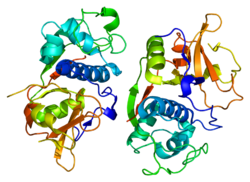

| CTSF | |||||||||||||||||||||||||||||||||||||||||||||||||||
|---|---|---|---|---|---|---|---|---|---|---|---|---|---|---|---|---|---|---|---|---|---|---|---|---|---|---|---|---|---|---|---|---|---|---|---|---|---|---|---|---|---|---|---|---|---|---|---|---|---|---|---|
 | |||||||||||||||||||||||||||||||||||||||||||||||||||
| |||||||||||||||||||||||||||||||||||||||||||||||||||
| Identifiers | |||||||||||||||||||||||||||||||||||||||||||||||||||
| Aliases | CTSF, CATSF, CLN13, cathepsin F | ||||||||||||||||||||||||||||||||||||||||||||||||||
| External IDs | OMIM: 603539; MGI: 1861434; HomoloGene: 31194; GeneCards: CTSF; OMA:CTSF - orthologs | ||||||||||||||||||||||||||||||||||||||||||||||||||
| |||||||||||||||||||||||||||||||||||||||||||||||||||
| |||||||||||||||||||||||||||||||||||||||||||||||||||
| |||||||||||||||||||||||||||||||||||||||||||||||||||
| |||||||||||||||||||||||||||||||||||||||||||||||||||
| |||||||||||||||||||||||||||||||||||||||||||||||||||
| Wikidata | |||||||||||||||||||||||||||||||||||||||||||||||||||
| |||||||||||||||||||||||||||||||||||||||||||||||||||
Cathepsin F is a protein that in humans is encoded by the CTSF gene.[5][6][7]
Cysteine cathepsins are a familyofcysteine proteases that represent a major component of the lysosomal proteolytic system. In general, cathepsins contain a signal peptide, followed by a propeptide and then a catalytically active mature region. The very long (251-amino acid residues) proregion of the cathepsin F precursor contains a C-terminal domain similar to the pro-segment of Cathepsin L-like enzymes, a 50-residue flexible linker peptide, and an N-terminal domain predicted to adopt a cystatin-like fold. The cathepsin F proregion is unique within the papain family cysteine proteases in that it contains this additional N-terminal segment predicted to share structural similarities with cysteine protease inhibitors of the cystatin superfamily. This cystatin-like domain contains some of the elements known to be important for inhibitory activity. CTSF encodes a predicted protein of 484 amino acids that contains a 19-residue signal peptide. Cathepsin F contains five potential N-glycosylation sites, and it may be targeted to the endosomal/lysosomal compartment via the mannose 6-phosphate receptor pathway. The cathepsin F gene is ubiquitously expressed, and it maps to chromosome 11q13, close to the gene encoding cathepsin W.[7]
Opisthorchis viverrini, a parasite, is typically detected by stool examination, specifically by counting eggs. However, this non-invasive, "gold standard" method can be unreliable in light infection and labor-intensive. An ELISA assay that detects the presence of the parasite's cathepsin F protein may be used as an alternative way to test for the parasite's presence.[8]
The Yesso scallop (Mizuhopecten yessoensis), was found in 2018 to express Cathepsin F in response to bacterial infection. The Yesso scallop has been suffering from high mortality due to bacterial diseases. Understanding the workings of its innate immune system, in various embryonic developmental stages, may help the associated aquaculture industry.[9]
|
| |
|---|---|
| Activity |
|
| Regulation |
|
| Classification |
|
| Kinetics |
|
| Types |
|
This article on a gene on human chromosome 11 is a stub. You can help Wikipedia by expanding it. |